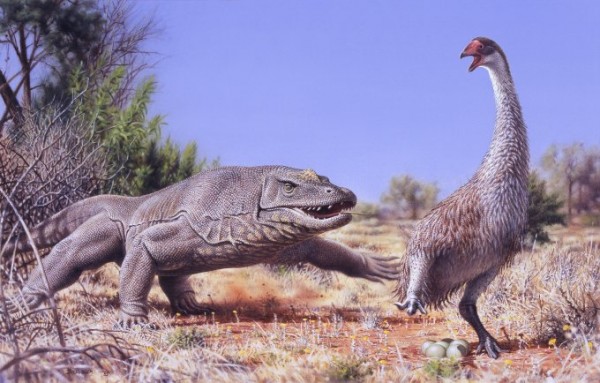By Ana Verayo, | January 30, 2016

An illustration of the giant, flightless bird known as Genyornis newtoni, surprised on her nest by a 1-ton predatory lizard named Megalania prisca in Australia roughly 50,000 years ago.
An ancient, flightless bird from Australia was apparently hunted down to extinction by humans, some 50,000 years ago according to a new study.
Researchers from the University of Colorado in Boulder consider this as the first direct evidence that suggests how humans can be one of the major causes of other species' extinction of early animals in Australia.
Like Us on Facebook
This flightless bird measures several feet high, weighing almost 500 pounds which is known by the scientific name, Genyornis newtoni. Researchers uncovered evidence of burnt eggshell fragments from the Genyornis, which is an indication that prehistoric humans were already collecting and eating eggs where the eggs are similar to the size of a cantaloupe, weighing 3.5 pounds each.
According to Gifford Miller of CU-Boulder's Institute of Arctic and Alpine Research, this is considered to be the first and only secure evidence that humans were directly responsible for the extinct Australian bird, where humans preyed on this species' eggs until they died out.
There are about 200 sites across Australia where these burnt Genyornis eggshells are found. The eggshell fragments were found to be inconsistently burnt and cooked, as some were partially blackened while others were severely burnt, indicating that the fragments were exposed to a wide range of heat temperatures.
Scientists believe that some of the blackened fragments were burned in transient, human made fires to cook and eat them, while others registered a gradient difference of almost 1,000 degrees Fahrenheit, which is impossible to produce within natural wildfires. Researchers were able to detect these different heat signatures by the decomposing amino acids inside the eggshell remnants.
It is still unknown how ancient wildfires were able to reach such high temperatures of more than a thousand degrees. Miller says that these conditions are still consistent how early humans harvest Genyornis eggs as they cook them over fires, and then leaving eggshell fragments as trash around their cooking fires.
Apart from the Genyornis, emu eggshell fragments were also uncovered from other similar Australian sites. The emu is also an Australian flightless bird, which is still living on the continent today, which is also smaller, weighing only 100 pounds.
Apart from the emus and the Genyornis, the Australian outback is also teeming with now extinct animals such as a giant a 1,000 pound kangaroo, a two ton wombat and a 25 foot lizard and even a tortoise the size of a small car.
Unfortunately, nearly 85 percent of Australia's early mammals, birds and reptiles that weigh over 100 pounds became extinct shortly after the arrival of the first humans who are believed to originate from the Indonesian islands some 700 miles away.
This new study is published in the journal Nature Communications.
-
Use of Coronavirus Pandemic Drones Raises Privacy Concerns: Drones Spread Fear, Local Officials Say

-
Coronavirus Hampers The Delivery Of Lockheed Martin F-35 Stealth Fighters For 2020

-
Instagram Speeds Up Plans to Add Account Memorialization Feature Due to COVID-19 Deaths

-
NASA: Perseverance Plans to Bring 'Mars Rock' to Earth in 2031

-
600 Dead And 3,000 In The Hospital as Iranians Believed Drinking High-Concentrations of Alcohol Can Cure The Coronavirus

-
600 Dead And 3,000 In The Hospital as Iranians Believed Drinking High-Concentrations of Alcohol Can Cure The Coronavirus

-
COVID-19: Doctors, Nurses Use Virtual Reality to Learn New Skills in Treating Coronavirus Patients







